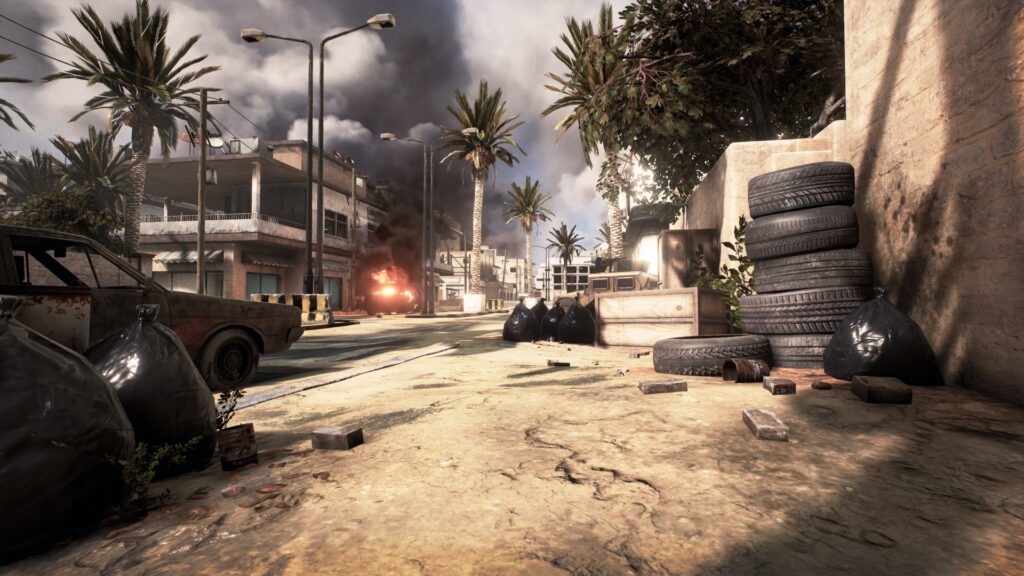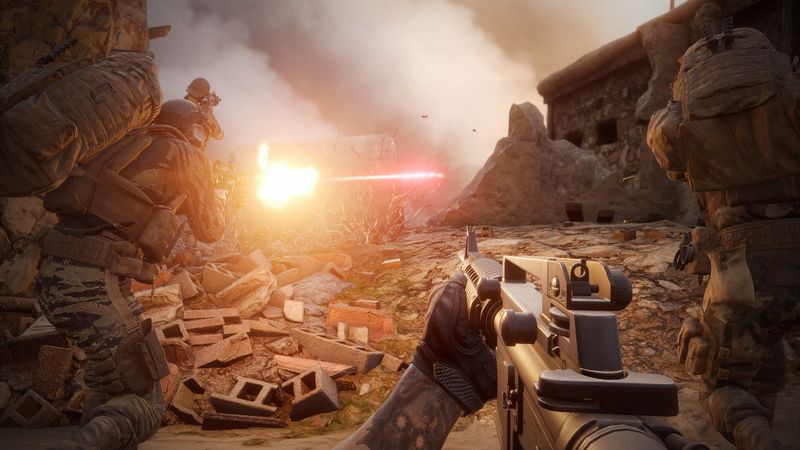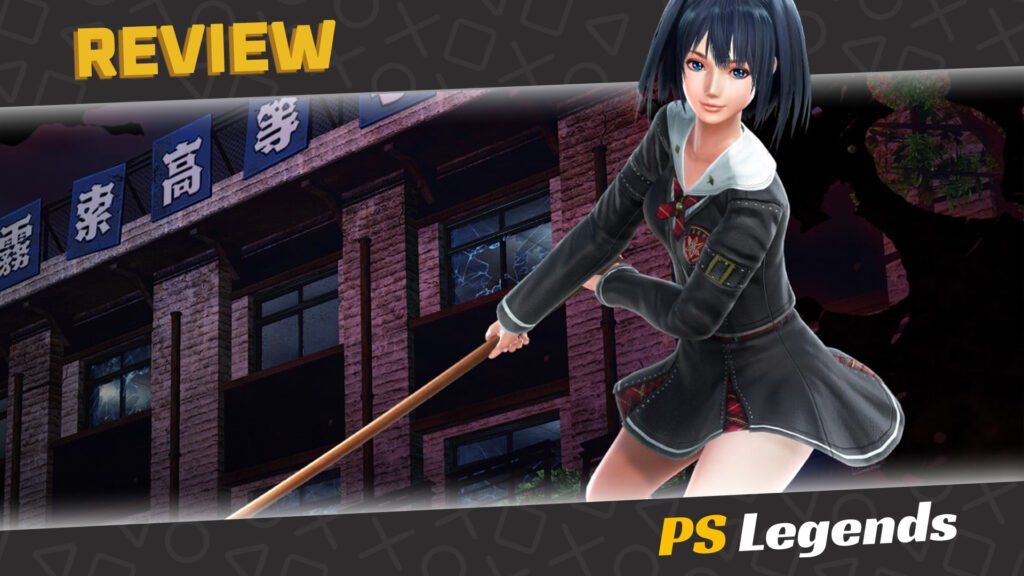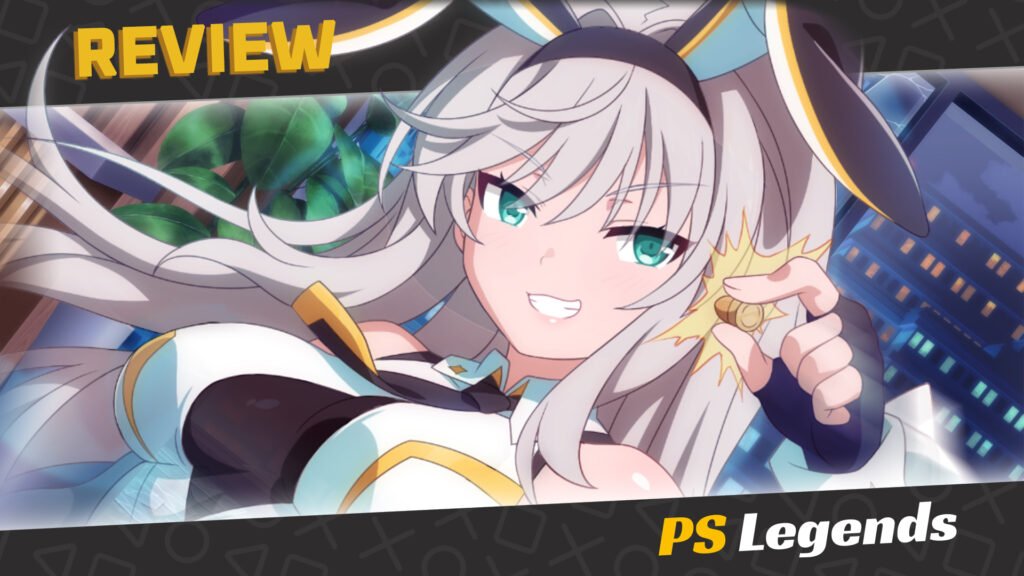The concept of Insurgency began with a mod for Half Life 2; from this mod spawned a standalone title, a spinoff, and a sequel Insurgency: Sandstorm. This game is focused and knows what it is doing, landing perfectly between mil-sim and first-person shooter. Unfortunately, Insurgency lacks a campaign, relying solely on it’s multiplayer. If you are like me, you won’t even notice. If you would like a deeper appreciation for the armed forces or just to challenge yourself, consider putting Insurgency: Sandstorm down range.
On This Page
Gameplay
Insurgency is as real as it gets. Bullets do real damage and cause real recoil. There is a very minimal hud. Having heavy equipment causes a slower walking/running speed. You even have to check your magazines to know what you’ve fired. It goes as far as it can before becoming too much to bear. Bearing that in mind, it is a hard game; there is no hand holding. If your team doesn’t cooperate you will not go far. A good team though, or a lot of individual skill, can lead to an amazing experience.
This is a very graphic game, best avoided by those with a weak stomach. The gore is quite detailed; explosions leave flesh strown about, grown men cry upon being shot, lungs gurgle as they fill with blood. I have played a lot of this game and it frequently becomes too much to handle. I could not be happier that someone has finally taken a console shooter this far.
As Insurgency has no campaign, there is not much detailing the conflict you are in. There is a security team that uses Western/NATO equipment and an insurgent team that uses a more varied arsenal, even some older weapons. Most maps are urban and desert environments, with long, medium, and close range combat occurring regardless. There are quite a few maps to chose from, being voted on most of the time.

All weapons are unlocked in the customization menu. Instead of earning your weapons and attachments, you instead have limited supply points to use, much like Black Ops 2. Everything you can equip uses these points with only a few exceptions. There is a lot to consider when building your classes: body armor, grenades, weapons attachments.
There are multiple classes to chose from as well. Most of these classes can only have a few players using them at a time. The Rifleman class is the standard class, using a variety of assault rifles and having no player limit. The Breacher class is a close quarters class, using close quarters weapons like shotguns and submachine guns. The Advisor class can chose from a range of exotic weapons; this class is quite versatile. The Marksman class is what it sounds like, using long range weapons to attack at range. The Gunner class can wield LMGs. The Demolitions class can wield ranged explosives, like RPGs, and other anti-personnel and anti-vehicle explosives. The Commander and Advisor class are especially important as they must cooperate to call in fire support; you will know they are being used properly when your team begins winning.
Game Modes

Versus
The versus category pits you against other players in a variety of different game modes. Sadly more than a few of these have no activity throughout most of the day. I haven’t been able to play firefight or defusal at all since starting this review (though I have played firefight a lot in the past).
Push – The attacking team has to capture a series of objectives, ending with the enemy cache which must be destroyed. Capturing objectives adds time to the match and respawn waves. The match ends when the cache is destroy or a team runs out of waves.
Frontline – Two teams fight over objectives towards each others caches, both attacking and defending. Respawn only occurs when an objective is secured. The match can end with a teams waves depleting or the cache being destroyed. This is a lot like Battlefield’s Conquest or Call of Duty’s Ground War.
Ambush – One team escorts a VIP to a designated area as the other team attempts to kill him. The VIP is very lightly armed and will not respawn. The match ends with the VIP dying or getting to his destination. This mode is high intensity with a lot of close quarters firefights and requires good team communication.
Domination – This is just plain old domination. Earn points by capturing the three objectives, respawn upon death, first to hit the threshold wins.
Firefight – Two teams fight over three objectives. Players do not respawn until an objective is captured. The match ends when a team is eliminated or all objectives are captured. This mode is one of the most intense as not playing the objective means you won’t get any backup.
Defusal – The insurgent team must destroy the objectives by planting explosives, earning points for each one destroyed. The security team defends the objective, earning points for each left standing when the round ends. This is only slightly different than classic search and destroy.
Free For All – Classic free-for-all. Infinite respawn, any class you want. The highest score upon the match ending wins.
Co-op
In the co-op modes you fight against large forces of enemy bots. The ai in this game is formidable. They can hold positions well, can throw molotovs accurately from long distances, and will move as a unit more often than not. The ai in Insurgency surprised me, given that games which rely on bots, like Enlisted, seem to struggle in making them effective without being overpowered.
Checkpoint – You and your team must capture or destroy a series of objectives, only winning once all are secured. The enemy ai may counter-attack any of these objectives, though a counter-attack on the final objective is guaranteed. Respawn requires an objective be captured or destroyed.
Hardcore Checkpoint – This is checkpoint mode with a more realistic approach. You will move slower, have fewer hud indicators, and less equipment. Upon death you will also spawn with only a bare bolt-action rifle and a sidearm.
Outpost – You must defend objectives against waves of enemy ai. If the enemies capture your current objective or eliminate your entire team, you will be pushed back to the next area. You will respawn after each wave; you also earn supply points after completing waves, resupplying between them.
Survival – Your team captures six objectives at random. You spawn with a pistol and after an objective is captured, supply crates will supply random weapons. You respawn when your team captures an objective.
Graphics and Sound
Graphically, Insurgency looks pretty good. The textures are not always pleasant to look at and there can be problems with textures looking funky, but otherwise it looks alright. The physics are ragdoll, so bodies drop where they stand and explosives send soldiers flying. The lighting is also well done, making night-vision matches fun enough.

The sound design is honest if it’s anything. Both player characters and AI make appropriate callouts and make unholy sounds when injured. When burning, characters shriek horrifically. When shot they wince, cry, or sometimes blood audibly fills there lungs. It is not often that a game takes immersion to this level. I appreciate the truth being told, as dark as it is.
Conclusion
Insurgency pushes the boundary of what we know as first-person shooters. There is no candy coating to help create appeal; I believe it finds a good place in between hardcore and casual. I can not help but feel as though something is missing though. The gameplay loop, though fun, grows stale after a while. A quality campaign or other alternate game mode would break up the monotony, I feel, and would also give some purpose to the little details on the maps. Overall this is a quality game, well worth the 40 dollar asking price.
Joys
- High-intensity combat
- Crazy attention to detail
Cons
- No story/campaign



